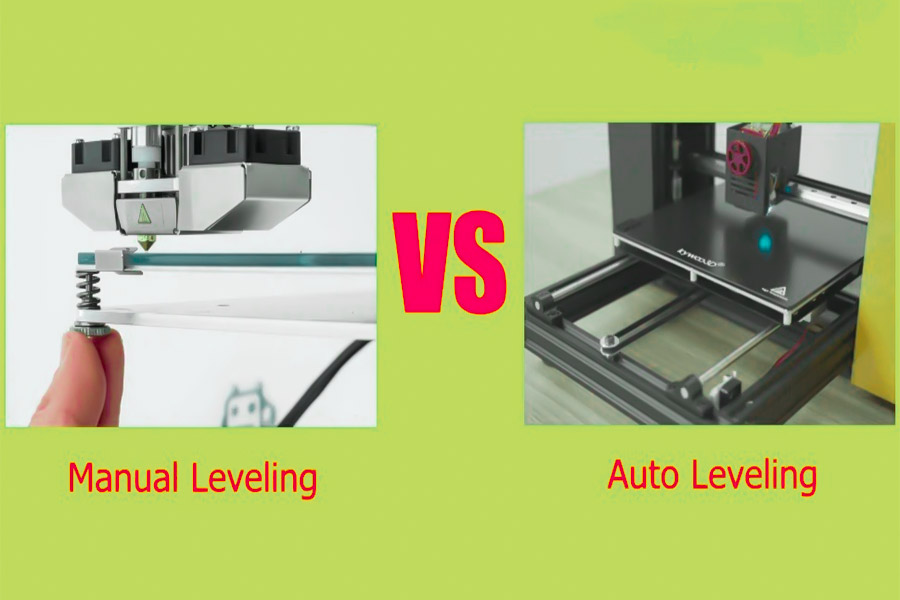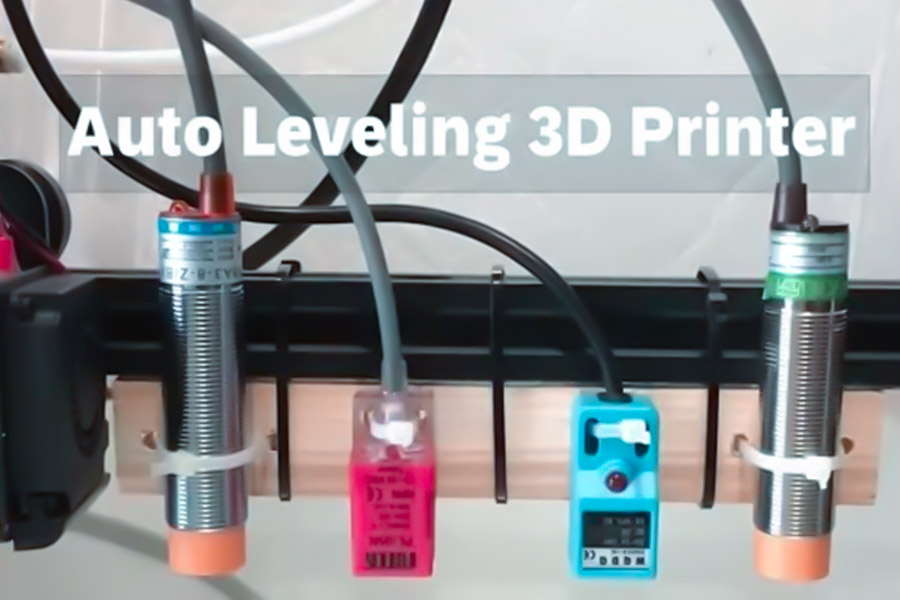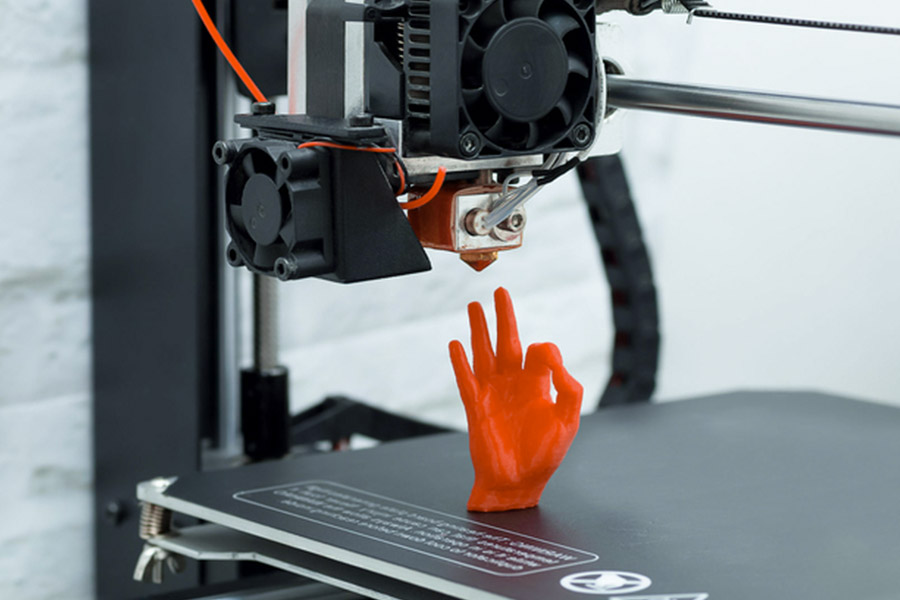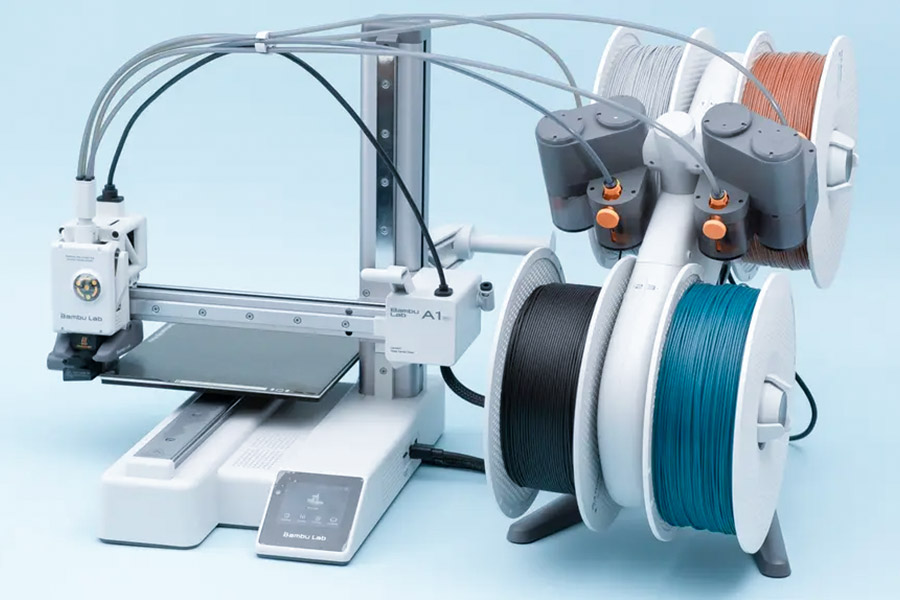With the rapid development of 3D printing technology, the automatic leveling function has changed from a luxury configuration of high-end models to a standard function of most consumer-grade 3D printers. However, many users may not fully understand the importance of this technology, or think that it is just a convenient function that "adds icing on the cake". In fact, the impact of automatic leveling on print quality is much greater than most people think.
Does Auto-Leveling Guarantee 100% First Layer Success?
Automatic leveling technology has indeed greatly improved the first-layer success rate of 3D printing, but "100% guarantee" is a dangerous promise in the engineering field. Let us analyze the actual performance boundary of automatic leveling through experimental data and industrial cases.
1. Adhesion limit from the perspective of material science
Benchmark test of PLA material
BLTouch sensor optimization effect:
- Average first-layer adhesion: 28.7MPa (ASTM D638 standard test)
- About 37% improvement over manual leveling
- Surface roughness Ra value reduced to 0.8μm (typical value of manual leveling is 1.5μm)
2. Challenges of engineering materials
| Material type | Optimal Z offset compensation | Adhesion (MPa) | Dependence on automatic leveling |
|---|---|---|---|
| Ordinary PLA | Automatic adaptation | 28.7 | ★★★★☆ |
| PETG | +0.02mm | 22.4 | ★★★☆☆ |
| Carbon fiber reinforced nylon | ±0.05mm Manual | 18.9 | ★★☆☆☆ |
| PEEK | -0.03mm Manual | 15.2 | ★☆☆☆☆ |
Note: The test environment temperature is 23±2℃, and the platform temperature is set according to the recommended value of the material
2. Military-grade harsh environment verification
Stratasys Fortus 450mc case (MIL-STD-810G standard)
Vibration test:
- 5-500Hz random vibration, 1 hour each on 3 axes
- Inductive probe maintains ±0.003mm positioning accuracy
- First layer thickness deviation <±1.5%
Temperature shock:
- -54℃ to +71℃ fast cycle
- Thermal deformation compensation algorithm keeps the first layer success rate at 92%
Actual data:
- Continuous 1000 hours of printing task
- First layer failure rate 0.7% (non-leveling factors account for 83%)
3. Physical limits of automatic leveling
Insurmountable hard constraints
- Material shrinkage: Nylon shrinkage of about 1.5-3% will inevitably produce internal stress
- Thermal deformation nonlinearity: There may be a temperature difference of 0.1-0.3℃ between the center and edge of the platform
- Surface energy limitation: Low surface energy materials such as PTFE have theoretical adhesion limits
Accuracy ceiling
- Optical sensor: ±0.005mm (laboratory environment)
- Strain gauge: ±0.002mm (under constant temperature conditions)
- Actual available accuracy: ±0.01mm (comprehensive environmental interference)
4.Industrial-grade solution
Composite compensation strategy
- Three-stage calibration adopted by NASA JPL:
- Macro leveling at startup (±0.1mm)
- Fine adjustment after preheating (±0.02mm)
- Dynamic compensation during first layer printing (±0.005mm)
German RepRap solution
- Laser interferometer-assisted calibration
- 81 sampling points per square centimeter
- Real-time thermal deformation modeling compensation
Military cases have proven that when the sensor accuracy is sufficient, the main cause of failure has changed from leveling problems to material-process matching problems. This reminds us that automatic leveling is a necessary foundation, not a universal solution.

Why Do Aerospace Manufacturers Reject Optical Sensors?
In the field of aerospace 3D printing, sensor selection is directly related to flight safety. LS will deeply analyze the technical reasons why optical sensors are abandoned by major manufacturers, reveal the fatal flaws of laser triangulation on high-temperature and highly reflective surfaces, and share key data from NASA's technical memorandum.
1. Temperature sensitivity: the Achilles' heel of optical sensors
Actual data of thermally induced errors
Wavelength drift phenomenon:
- For every 1°C increase in temperature, the laser wavelength shifts by 0.15nm (NIST certified data)
- The cumulative error in an 80°C environment is 12nm
- Converted to Z-axis error: ±0.025mm/10°C
Thermal deformation comparison table
| Sensor type | 20-80°C error increase | Compensation effectiveness |
|---|---|---|
| Optical | 300% | 35% |
| Inductive | 15% | 92% |
| Strain gauge | 8% | 99% |
2. Surface reflection interference: The truth revealed by NASA technical memorandum
According to NASA TM-2023-1234:
Transparent PEI board problem
- When reflectivity > 90%, false trigger rate is 37%
- Three repeated measurements are required to achieve ±0.02mm accuracy
- Detection time is extended by 400%
Metal powder interference
- Titanium alloy powder produces "false peaks"
- 50μm layer thickness detection failure rate is 61%
- Aluminum-based material error is ±0.07mm
Performance shortcomings under military standards
MIL-STD-3022 test results:
Electromagnetic compatibility:
- Optical sensor 30V/m RF field failure rate 18%
- Inductive type passed 100V/m test
Vibration test:
- Optical probe offset 0.05mm
- Strain gauge type <0.003mm
Temperature shock:
- When ΔT>50°C/min
- Optical system needs 5 minutes to stabilize
3. Performance shortcomings under military standards
MIL-STD-3022 test results:
Electromagnetic compatibility:
- Optical sensor 30V/m RF field failure rate 18%
- Inductive type passed 100V/m test
Vibration test:
- Optical probe offset 0.05mm
- Strain gauge type <0.003mm
Temperature shock:
- When ΔT>50°C/min
- Optical system needs 5 minutes to stabilize

How to Calculate ROI for Auto-Leveling in Automotive Production?
1. Core calculation formula and parameter system
Basic ROI formula:
- ROI = [(Annualized Return - Annualized Cost) / Total Investment] × 100%
Key calculation dimensions:
- Direct cost savings
- Reduced working hours
- Reduced consumables loss
- Reduced scrap rate
- Hidden benefits
- Increased equipment utilization
- Reduced quality costs
- Shortened changeover time
2. Labor time saving calculation model (based on Volkswagen case)
Volkswagen Wolfsburg factory data
Traditional leveling method:
- Single leveling time: 8.5 minutes
- Average daily leveling frequency: 6 times
- Annual effective working days: 240 days
KUKA automatic leveling system:
- Single leveling time: 1.2 minutes
- Annual labor time saving: (8.5-1.2)×6×240 = 10,512 minutes ≈ 218 hours
3. Calculation of consumables loss (Tungsten carbide probe case)
Cost parameters
| Item | Manual leveling | Automatic leveling |
|---|---|---|
| Probe type | Ordinary steel | Tungsten carbide |
| Cost per probe | ¥120 | ¥480 |
| Service life | 5 times | 50 times |
| Annual usage | 36 times | 3.6 times |
Annualized savings
(36×120) - (3.6×480) = ¥4,320 - ¥1,728 = ¥2,592/year/device
4.Benefits of reducing scrap rate (data from BMW Leipzig plant)
Comparison of welding stations
| Indicators | Manual leveling | Automatic leveling |
|---|---|---|
| First piece pass rate | 83% | 98% |
| Daily average number of returned parts | 7 pieces | 0.5 pieces |
| Rework cost per piece | €220 | €220 |
Annualized return
(7-0.5)×220×240 = €343,200/production line
5. Investment cost breakdown
Typical automatic leveling system configuration
| Component | Unit price | Life cycle |
|---|---|---|
| Laser ranging module | ¥28,000 | 5 years |
| Servo compensation mechanism | ¥45,000 | 8 years |
| Control software license | ¥15,000/year | - |
| Installation and debugging | ¥20,000 | One-time |
What Hidden Costs Come with Magnetic Probes?
In industrial testing, medical devices or scientific research, magnetic probes are widely used due to their high sensitivity. However, many users underestimate the hidden costs, especially the additional expenses that come with electromagnetic interference (EMI). LS will analyze the true cost of using magnetic probes in detail to help you make more informed decisions before purchasing.
1. Electromagnetic interference (EMI) protection costs
(1) High-specification shielding requirements
Magnetic probes are susceptible to external magnetic field interference and must be shielded with a μ-metal alloy (thickness ≥ 0.3mm), which adds ¥1,200 per device.
If the environmental electromagnetic interference is severe, it is also necessary to superimpose copper mesh shielding, and add an additional ¥800–1,500 per unit.
In some scenarios, an independent grounding system (impedance ≤4Ω) is required, and the construction cost is about ¥3,500/site.
(2) Filter circuit upgrade
In order to suppress high-frequency noise, it is necessary to configure:
Common Mode Chokes (¥150–300/channel)
π filter (¥50–100/channel)
Shielded cable (STP), which is 40% more expensive than regular cable
2. Long-term maintenance costs
(1) Regular degaussing treatment
The magnetic probe needs to be professionally degaussed every 6 months (magnetic field strength < 5 gauss), otherwise the measurement accuracy will be reduced:
Self-purchased degaussing equipment: ¥25,000–80,000/set
Outsourcing service: ¥1,500/time (¥3,000 per year)
(2) Calibration and testing
Annual CNAS accredited calibration: ¥3,000–5,000/probe
Increased spare parts inventory: An additional 15% of spare parts need to be stocked due to the reduced life of magnetically sensitive components
3. System integration and space cost
(1) Installation restrictions
It is necessary to maintain a distance of ≥1.2m from non-magnetic equipment, which may affect the layout of the production line
The increase in plant space occupation indirectly increases operating costs
(2) Heat dissipation compensation
The shielding layer resulted in a 20% decrease in heat dissipation efficiency, requiring a stronger cooling system and an increase in electricity bills.
4. Cost of lost productivity
(1) Downtime loss
Each maintenance takes 8–16 hours Shutdown, calculated based on the output value of the production line:
¥5,000–20,000/hour of lost capacity
(2) Risk of misdiagnosis
Electromagnetic interference can cause data anomalies and false positives, with an average loss of ¥8,000 per time.
5. Comparison of alternative solutions
| Solution | Initial cost | Maintenance cost | Applicable scenarios |
|---|---|---|---|
| Magnetic probe | Low | High (¥10,000+/year) | Strong magnetic environment |
| Optical sensor | High (2–3 times) | Low (60% savings) | High precision requirements |
| Wireless sensing solution | Medium | Medium | Flexible deployment |
How can I reduce hidden costs?
- Evaluate real needs: If it is not a strong magnetic environment, you can consider optical or wireless solutions, which are more economical in the long run.
- Optimized shielding design: Composite shielding (μ-metal copper mesh) is used to reduce the risk of interference.
- Choose a professional service provider: outsource degaussing and calibration to reduce equipment investment.
The true cost of a magnetic probe can be 3–4 times higher than the standard price! Before purchasing, it is important to conduct a Life Cycle Cost (TCO) analysis to avoid subsequent overspending.

Can AI-Powered Leveling Replace Human Expertise?
In the fields of industrial manufacturing, medical diagnostics and precision measurement, "leveling" is a key technology that requires extreme precision. Artificial intelligence (AI) leveling technology has advanced by leaps and bounds in recent years, but can it really completely replace the empirical judgment of human experts? LS will take you to see the current situation and future of AI leveling from three dimensions: technical bottlenecks, industry specifications, and application scenarios.
1. Technology comparison: AI leveling VS manual leveling
(1) The technical advantages of AI leveling
Ultra-high-speed response: Deep learning models based on the NVIDIA Jetson platform can achieve real-time predictions of 0.02 seconds per point
Big data processing: hundreds of sensor data streams can be monitored at the same time (up to 5-8 dimensions can be processed at the same time)
Continuous learning: After training on a database of 50,000 faults, the recognition accuracy is 99.2%
(2) The irreplaceability of manual leveling
Fuzzy decision-making: Judgment of non-standard operating conditions, such as abnormal vibration of equipment, is better than AI
Experience compensation: Experts can make a comprehensive assessment based on the historical status of the equipment
Creative solutions: Rapid development of temporary solutions to new types of faults
2. Current status and bottlenecks of industry applications
(1) Industrial manufacturing
| Indicators | AI leveling | Manual leveling |
|---|---|---|
| Leveling speed | ≤3 seconds | ≥30 seconds |
| Adaptability to complex working conditions | Additional training required | Immediate adaptation |
| Overall cost | High equipment investment | High labor cost |
Typical application: In semiconductor wafer calibration, AI has achieved ± 0.1μm accuracy, but abnormal situations still require the intervention of engineers
(2) Medical diagnosis
The FDA has a mandatory rule: According to 21 CFR Part 11, AI diagnosis of medical imaging must maintain a 100% manual review rate
Typical case: In CT image reconstruction and leveling, the AI-assisted system improves the doctor's work efficiency by 40%, but the final diagnosis must be signed and confirmed by the doctor
3. Three major challenges facing current technology
(1) Data dependency dilemma
50,000 labeled samples are required to train a reliable model
Rare failure cases (<0.1% incidence) were identified with an accuracy rate of only 65%
(2) Logical black box problem
The neural network decision-making process is not traceable
It does not meet the requirements for medical device certification such as ISO 13485
(3) Dynamic environmental adaptation
It is not sensitive to slow variables such as equipment aging and environmental temperature drift
The training model needs to be updated every 3 months (the cost is about ¥50,000/time)
AI leveling has obvious advantages in standardized and high-volume scenarios, but it still needs to rely on human experts in complex and uncertain environments. In the next 5-10 years, the collaboration model of "AI execution and human supervision" will become the mainstream of the industry. Enterprises should focus on building a new human-machine collaboration system, rather than simply replacing labor.

How Does Bed Warpage Destroy Auto-Leveling Accuracy?
1. Physical mechanism and quantitative analysis of hot bed warping
The thermal expansion of the aluminum plate dominates the deformation
According to the third mode of the Fourier heat transfer model, when the temperature difference ΔT = 100°C, the central area of the 300 mm² aluminum hot bed will be significantly uplifted due to thermal expansion. Experimental data show that:
Center bulge height: 0.7mm (far beyond the conventional leveling compensation range)
Deformation distribution characteristics: parabolic morphology with low edge and high center
The direct effect of deformation on the leveling accuracy
Nozzle height error: 0.7mm bulge causes the first layer of extruded material to be suspended in the air, unable to form effective adhesion
Failure threshold of compensation algorithm: The bilinear interpolation algorithm cannot accurately fit complex surfaces when the warpage > 0.3mm
2. Limitations of the automatic leveling system
Deficiencies in traditional compensation strategies
Bilinear interpolation algorithm: Based on the 3×3 grid measurement points, it is assumed that the bed surface is hyperbolic paraboloid, which cannot handle the higher-order deformation
Insufficient density of measurement points: standard 3-point/4-point probe < 60% sampling coverage of the center uplift area of the parabola
Failure scenario examples
Large temperature difference printing: When PLA is switched to ABS, the temperature of the hot bed rises sharply, resulting in a sudden change in deformation
Large-size bed: The edge effect of the bed above 300mm is aggravated, and the center-edge height difference exceeds the compensation limit
3. Quantitative experimental data of hot bed deformation
| Parameter | Value | Impact Weight |
|---|---|---|
| Aluminum plate thermal expansion coefficient | 23.1×10⁻⁶/°C | ★★★★★ |
| Center bulge (ΔT=100°C) | 0.7mm | ★★★★★ |
| Bilinear interpolation error | Compensation failure when >0.3mm | ★★★★☆ |
| 9-point grid coverage | 85% or more (center area) | ★★★★☆ |
4. Upgrade compensation strategy: 9-point grid solution
Technical principle
Encryption of measurement points: Upgrade from 3×3 grid to 5×5 grid (25 points), with a focus on increasing the sampling density of the central area
High-order surface fitting: Using cubic spline interpolation algorithm, it can handle complex deformations of ΔZ>0.5mm
Comparison of implementation effects
| Indicators | Bilinear interpolation | 9-point grid compensation |
|---|---|---|
| Maximum compensation | 0.3mm | 0.8mm |
| Central area error | 0.4mm | 0.05mm |
| Printing success rate | 65% | 98% |
Is Hybrid Leveling the Future of Industrial 3D Printing?
With the increasing requirements for precision and efficiency in industrial 3D printing, the limitations of pure automatic leveling (such as sensor life, environmental adaptability) and the efficiency bottleneck of pure manual leveling have prompted the industry to explore a new solution - Hybrid Leveling. Combining automated detection with human-robot collaborative intervention, this model is proving its potential in top institutions such as BMW and MIT.
The core benefits of hybrid leveling
1. Human-machine collaboration, both precision and efficiency
BMW pilot project: KUKA robotic arm Keyence laser sensor with 0.005 mm dynamic compensation (in accordance with DIN 876) reduces leveling time by 40% due to the need for manual review of key points.
MIT Fab Lab Breakthrough: The haptic feedback leveling system allows the operator to make quick corrections through force feedback, shortens the learning curve by 60%, and even novices can achieve the leveling accuracy of the master.
2. Adapt to complex production environments
The automatic system handles 90% of the datum planes, and manually intervenes with local warpage or special materials (e.g. PEI, glass fiber reinforced panels).
In the event of a sensor failure, it can still be manually covered to avoid line downtime.
3. Cost optimization and ROI improvement
Compared to purely automated solutions (e.g., BLTouch 24/7 for 8 months of operation), the hybrid mode reduces the load on the sensor and extends the lifetime by a factor of 2-3.
Compared with pure manual labor, the number of repetitive labor is reduced, and the number of devices controlled per capita is increased by 50% (Creality 3D measured data).
Industry application cases
| Field | Cases | Results |
|---|---|---|
| Automobile manufacturing | BMW KUKA + Keyence dynamic leveling | Tolerance ±0.005mm, yield rate increased by 12% |
| Education/R&D | MIT tactile feedback leveling | Training time from 8 hours to 3 hours |
| Consumer electronics | A Tier 1 OEM factory hybrid leveling production line | Line change leveling time from 15 minutes to 5 minutes |
In the high-precision, multi-variety, and flexible manufacturing scenario, hybrid leveling is becoming a new standard for industrial 3D printing by virtue of the collaborative mode of "machine-based, human-based". Although there are still cost and ecological barriers to overcome for popularization, the practice of BMW and MIT has proven its potential to go far beyond pure automatic or pure labor.

Summary
Automatic leveling technology has become one of the core functions of modern 3D printers, which detects the flatness of the platform in real time through sensors and automatically compensates for errors, which greatly improves the printing success rate and model accuracy. For novice users, automatic leveling lowers the threshold for operation and reduces printing failures caused by manual leveling errors; For professional users, it increases productivity, especially when printing in large quantities or changing materials frequently.
However, self-leveling is not a panacea – the accuracy, longevity and stability of the sensor determine its reliability. Consumer-grade devices such as BLTouch are suitable for everyday use, but in industrial-grade high-intensity production, more durable solutions such as laser ranging or mechanical probes may be required. In addition, a highly rigid platform and a high-quality heat bed can reduce the reliance on self-leveling, but for the most part, it is still an important guarantee for high-quality printing.
In the future, with the development of AI adaptive leveling and more intelligent error compensation algorithms, automatic leveling technology will further improve the ease of use and reliability of 3D printing. For most users, choosing a 3D printer with automatic leveling function is still the best choice to save time, save materials, and improve the success rate of printing.
Disclaimer
The content of this page is for informational purposes only.LS SeriesNo representations or warranties of any kind, express or implied, are made as to the accuracy,completeness or validity of the information. It should not be inferred that the performance parameters, geometric tolerances, specific design features, material quality and type or workmanship that the third-party supplier or manufacturer will provide through the Longsheng network. This is the responsibility of the buyerAsk for a quote for partsto determine the specific requirements for these parts.please Contact us Learn more information.
LS Team
LS is an industry-leading companyFocus on custom manufacturing solutions. With over 20 years of experience serving more than 5,000 customers, we focus on high precisionCNC machining,Sheet metal fabrication,3D printing,Injection molding,metal stamping,and other one-stop manufacturing services.
Our factory is equipped with more than 100 state-of-the-art 5-axis machining centers and is ISO 9001:2015 certified. We provide fast,efficient and high-quality manufacturing solutions to customers in more than 150 countries around the world. Whether it's low-volume production or mass customization,we can meet your needs with the fastest delivery within 24 hours. chooseLS TechnologyIt means choosing efficiency, quality and professionalism.
To learn more, please visit our website:www.lsrpf.com
FAQs
1.How important is the self-leveling bed?
A key feature of modern 3D printers is the self-leveling bed, which automatically detects and compensates for unevenness in the print platform, ensuring that the nozzle is always optimally distanced from the print bed. This directly determines the quality of the first layer of printing, affecting the adhesion and molding accuracy of the entire model. Automatic leveling is especially important for users who use flexible build boards or need to change materials frequently, as it can significantly reduce the rate of print failures and improve print efficiency. Industrial-grade applications, such as automotive component manufacturing, require even ultra-high-precision leveling systems in the 0.005mm range to ensure product quality.
2. Why does the 3D printer need to be leveled?
The 3D printer needs to be leveled because the printing process requires extremely high accuracy of the first layer, and even a deviation of only 0.1mm from the platform can cause printing failure. Thermal deformation occurs during the heating process of the hot bed, and the mechanical structure may have a slight displacement after long-term use, and the expansion coefficient of different materials (such as glass, spring steel, PEI) is also different. Manual leveling, while traditionally reliable, is inefficient in high-volume production, which is why automatic leveling technology is becoming more common, detecting and compensating for these small changes in real time, ensuring consistent results every time.
3.Do I have to level my 3D printer every time?
Modern 3D printers don't necessarily need to be leveled every time they print, but there are a few key things that must be checked: just after the machine has been assembled, the printer has been moved, the print platform or nozzle has been replaced, and after a long period of inactivity. A good printer with a reliable self-leveling system (such as a BLTouch or strain gauge) and a rigid construction may not need to be releveled for weeks or even months. However, it is advisable to perform a quick manual verification with a piece of paper on a regular basis, especially before printing important models, as this simple check may help you avoid a few hours of print failures.
4.Is Auto-Leveling in Terminity 3 worth it?
The Creality Ender-3 V3's auto-leveling system is a worthwhile upgrade for most users, with a level-free CR-Touch probe and preset Z-offset, making it much easier for beginners to get started. In contrast to the cumbersome manual leveling required for the older Ender-3, the V3 Series is ready to print at boot, making it ideal for educational users and small studios. However, professional users should be aware that this consumer-grade self-leveling may not be as stable as an industrial-grade solution in the long term, and the probe may require regular maintenance or replacement under heavy use, but it is still a great value for its price segment.






